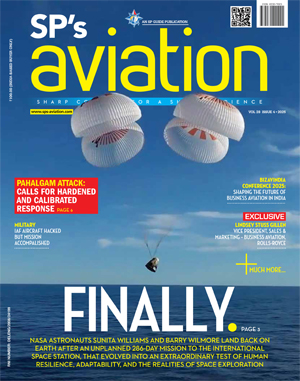INDIAN ARMED FORCES CHIEFS ON OUR RELENTLESS AND FOCUSED PUBLISHING EFFORTS

The insightful articles, inspiring narrations and analytical perspectives presented by the Editorial Team, establish an alluring connect with the reader. My compliments and best wishes to SP Guide Publications.

"Over the past 60 years, the growth of SP Guide Publications has mirrored the rising stature of Indian Navy. Its well-researched and informative magazines on Defence and Aerospace sector have served to shape an educated opinion of our military personnel, policy makers and the public alike. I wish SP's Publication team continued success, fair winds and following seas in all future endeavour!"

Since, its inception in 1964, SP Guide Publications has consistently demonstrated commitment to high-quality journalism in the aerospace and defence sectors, earning a well-deserved reputation as Asia's largest media house in this domain. I wish SP Guide Publications continued success in its pursuit of excellence.
- The layered Air Defence systems that worked superbly, the key element of Operation Sindoor
- Operation Sindoor | Day 2 DGMOs Briefing
- Operation Sindoor: Resolute yet Restrained
- India's Operation Sindoor Sends a Clear Message to Terror and the World – ‘ZERO TOLERANCE’
- Japan and India set forth a defence cooperation consultancy framework, talks on tank and jet engines
Unwarranted Delays

There is undoubtedly a compelling urgency to finalise the MMRCA deal without further delay to ensure that for the IAF, the Rafale is a reality and that the MMRCA tender does not continue to remain an exercise in chasing a mirage!
It was ov er a decade ago that the Indian Air Force (IAF) first projected a requirement of six squadrons (126 aircraft) of light-weight air defence fighters in the 15- to 20-tonne weight category. This requirement was projected essentially to fill the void in its combat fleet anticipated due to the retirement of the air defence version of the MiG-21 aircraft. The proposal gradually metamorphosed into the requirement for 126 medium multi-role combat aircraft (MMRCA) of heavier weight i.e. 25 tonnes. Though not officially stated in explicit terms, the IAF indicated its preference for twin-engine and twoseat platform to conform to its newly formulated doctrine.
After a delay of six years, an elaborate 211-page request for proposal (RFP) was issued in 2007. Thereafter, it took a couple of years for the response to the RFP to be collated. What followed was a detailed technical evaluation, gruelling field trials to check compliance with the 660 technical parameters under a variety of operational conditions and locations as also a preliminary commercial evaluation, the entire process lasting for over five years. Finally, end-January this year, the IAF made public its preferred aircraft, the Rafale, fielded by the French aerospace major Dassault. The Rafale was selected by the IAF from amongst six contenders, others being the Eurofighter Typhoon, Boeing F/A18-E/F Super Hornet, Lockheed Martin F-16IN Super Viper, Saab Gripen and the Russian MiG-35.
On account of the inordinate delay in the acquisition process attributable to a large extent to the infinitely complex Defence Procurement Procedure (DPP) that demands high degree of procedural discipline, competitiveness, transparency and fairness, the value of the contract initially in the region of $10.4 billion ( Rs. 57,200 crore), has escalated and the revised estimate is nudging at $20 billion ( Rs. 1,10,000 crore). As and when the deal finally goes through, it will go down in the history of defence procurement as the largest deal under the “open tender” system not only in India but in the world.
Since end-January 2012, when the selection of the preferred vendor was made public, the acquisition process has moved to the next stage; that of detailed commercial negotiations between the Indian Ministry of Defence and the French aerospace major Dassault. This round of interaction would include computation and verification of data on life cycle costs, finalisation of offset arrangements, transfer of technology and fixation of the final price. After scrutiny by the Ministry of Finance, the case will be considered for approval by the Cabinet Committee on Security before the contract is finally inked.
At the time the selection of the Rafale was made public, it was estimated that it would take another four to five months for the contract to be signed. But seven months have gone by and there is no indication that the process is nearing completion or even moving forward. Delay in the finalisation of the contract is undoubtedly frustrating for the IAF as its plans to check the rapidly eroding operational potential through induction of new aircraft are unlikely to materialise in the required time frame. The pace at which the process has progressed so far, the chances of the contract being concluded during the current financial year are beginning to appear rather slim, raising serious doubts about the possibility of induction of the first batch of Rafale aircraft procured from the original equipment manufacturer (OEM) in a fly-away condition, beginning 2015. Plans for the commencement of manufacture of the aircraft by the Hindustan Aeronautics Limited by 2017-18 may therefore not materialise and would have to be pushed back further.





